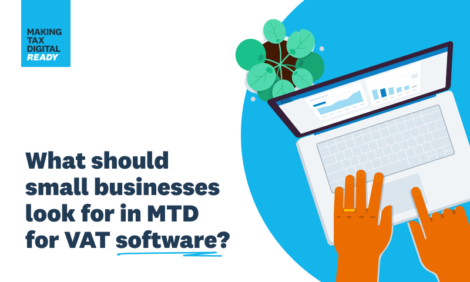
What should small businesses look for in MTD for VAT software?

Analysis paralysis is a very real thing, and not just an excellent name for a heavy metal band. It describes what happens when an individual or group over analyses a situation to such an extent that no solution is ever reached.
This can be as minor as struggling to pick a new Netflix show, or as major as a small business deciding on a digital tool that could not only help them thrive in the future, but ensure they remain compliant with government legislation. That’s right, we’re talking about Making Tax Digital (MTD).
Choosing the right accounting software for MTD is vital – not only helping to ensure you’re fulfilling your compliance requirements, but in allowing you to achieve the benefits of automation and digitalisation. This is the potential of MTD, with small businesses able to use it as a springboard for broader digital transformation, driving greater efficiencies through the use of new technology.
This opportunity is arriving soon. The next phase of MTD for VAT means that from April 2022, VAT-registered businesses with taxable turnover under £85,000 that are submitting VAT via the HMRC portal or through the post will have to maintain records digitally and file through MTD-compatible software, like Xero.
Here, we run through the thinking behind compatible software, and the key things to consider when weighing up your options.
Keep it compatible
First, let’s get the technical jargon out of the way. HMRC uses APIs (Application Programming Interfaces), which allow two software programmes to exchange data. APIs have resulted in the creation of MTD compliant software for businesses of all types and sizes, including those in markets that may be regarded as niche.
So, what should you look for when seeking out an MTD-compliant software?
- Before diving into the process of identifying new software, it’s worth checking whether your current provider is MTD for VAT compliant. You can do this by searching for them on HMRC’s list. You can also filter the list to show the providers that cater for certain accessibility needs.
- Just because a software is compliant, doesn’t mean you should rush to adopt it. Not every software provider will work for your business, and getting this wrong can create unwanted disruption. With this in mind, you should carefully consider what would work best for your specific needs. For example, limited companies with employees may benefit from MTD compatible software that has payroll features, or that integrates directly with third-party payroll software.
- It’s worth considering the phrase, ‘you get what you pay for’ when weighing up the software for you. Free options may be available, but there’s a good chance that these providers won’t have the investment or resources to build out the features you need for your business. To find out if this is the case, make sure you look at the additional features listed that could help you with general business management. Xero, for example, offers an array of features to not only enable you to manage MTD for VAT, but also to help you to run a healthy business. Turning to software that can provide greater value to your business will likely be worth that extra expenditure.
While this should offer you a helpful starting point for identifying the right MTD for VAT software for your business, we have a whole host of other resources for accountants and small businesses, including a breakdown of the key deadlines for MTD.
The post What should small businesses look for in MTD for VAT software? appeared first on Xero Blog.
Source: Xero Blog






